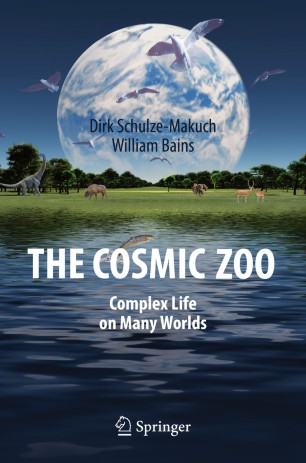NASA Develops a Scale for Assessing the Chances of ET Life
We’ve come a long way from mere snatches of (maybe) information to the need for standards in evaluating the expected incoming massGeoscientist Dirk Schulze-Makuch, co-author with William Bains of The Cosmic Zoo (2017) and a number of other books on planetary habitability, thinks science needs standardized scales for assessing claims about extraterrestrial life.

There are lots of claims: life on Mars detected by the Viking landers (1976), fossil life in a Mars-origin meteorite (1996), phosphine on Venus (2020) … all have some evidence in their favor. But scientists need a way to express degrees of certainty. Recently, NASA has proposed the Confidence of Life Detection Scale (CoLD), featuring seven benchmarks.
The main problem is that evidence that might suggest life could just as easily be a non-biological process:
Consider Jupiter’s moon Europa. A large asteroid impact could have volatilized ice on the surface, creating a water vapor atmosphere. Radiation from Jupiter could then have split the water molecules into oxygen and hydrogen, leaving the lighter hydrogen to escape to space and the heavier oxygen to be left behind. Just as with Europa, the discovery of oxygen in an exoplanet’s atmosphere, exciting at first, could turn out to have a purely physical explanation.
Finding large amounts of big organic molecules like chlorophyll in an alien atmosphere would be more exciting, since they are not known to form under abiotic conditions. By itself, however, that wouldn’t likely be proof enough. There would always be the nagging suspicion that some unknown non-biological chemistry is responsible.
Dirk Schulze-Makuch, “Alien life: What would constitute “smoking gun” evidence?” at Big Think (March 29, 2022)
But, with so many new exoplanets coming into the view of the powerful new telescopes, a scale for assessing claims is an alternative to endless inconclusive buzz. NASA, for one, is on board with that:
The scale contains seven levels, reflective of the winding, complicated staircase of steps that would lead to scientists declaring they’ve found life beyond Earth. As an analogy, Green and colleagues point to the Technology Readiness Level scale, a system used inside NASA to rate how ready a spacecraft or technology is to fly. Along this spectrum, cutting-edge technologies such as the Mars helicopter Ingenuity begin as ideas and develop into rigorously tested components of history-making space missions.
The authors hope that in the future, scientists will note in published studies how their new astrobiology results fit into such a scale. Journalists could also refer to this kind of framework to set expectations for the public in stories about new scientific results, so that small steps don’t appear to be giant leaps.
Elizabeth Landau, “Are We Alone in the Universe? NASA Calls for New Framework” at NASA Astrobiology (October 27, 2021)
Here’s the scale:

James Green, NASA’s chief scientist spearheaded the scale:
The paper’s authors stress that the scale is merely a starting point for a larger conversation with scientists and science communicators about the best ways to proceed if and when we discover evidence of alien life.
It also comes in the context of the upcoming launch of the powerful James Webb telescope, along with the Perseverance Mars rover searching for life on the Red Planet, meaning that such a finding might become a reality sooner rather than later.
Tony Tran, “NASA says we need a plan for when we discover alien life” at Futurism (October 28, 2021)
Relative to where we stood decades ago, there are many clues to sift through, for example:
[Maggie] Thompson and her colleagues note that “methane is the only biosignature that the James Webb Space Telescope could readily detect in terrestrial atmospheres,” making it “imperative to understand methane biosignatures to contextualize these upcoming observations,” according to a study published Monday in Proceedings of the National Academy of Sciences.
Scientists are already trying to find biosignatures in the atmospheres of exoplanets that could hint at the presence of life, such as oxygen, oxone, and carbon dioxide. However, the molecular properties of methane line up with the JWST’s sweet observational spot at near-infrared wavelengths, making it a particularly important compound in the search for extraterrestrial life.
Becky Ferreira, “Scientists Are Preparing for Our Best Shot Yet at Identifying Alien Life” at Vice (March 28, 2022)
We’ve come a long way from mere snatches of (maybe) information to the need for standards for evaluating the expected incoming mass of data.
You may also wish to read:
The Drake equation at 60 years: The second most famous equation After e = mc2. New technology is improving our ability to search the skies for signs of possible extraterrestrial civilizations. Whatever the fate of current ET detection projects, a design filter of the sort proposed beats squabbling about the probability without collecting any data.
Astrophysicist: Stop looking for extraterrestrial civilizations. And accept that ‘Oumuamua was a natural object, though a very mysterious one. Paul Sutter is not saying that ET isn’t out there but that evidence of biosignatures (life) is more useful than technosignatures (intelligent life).
and
Will religions crumble if we find extraterrestrial life? NASA funded a group of theologians to try to assess the probable reaction of religious people to extraterrestrial life or intelligent aliens. Theologian and astrobiologist Andrew Davison reports in his forthcoming book that religious acceptance of extraterrestrials is strong and goes back a long way.
